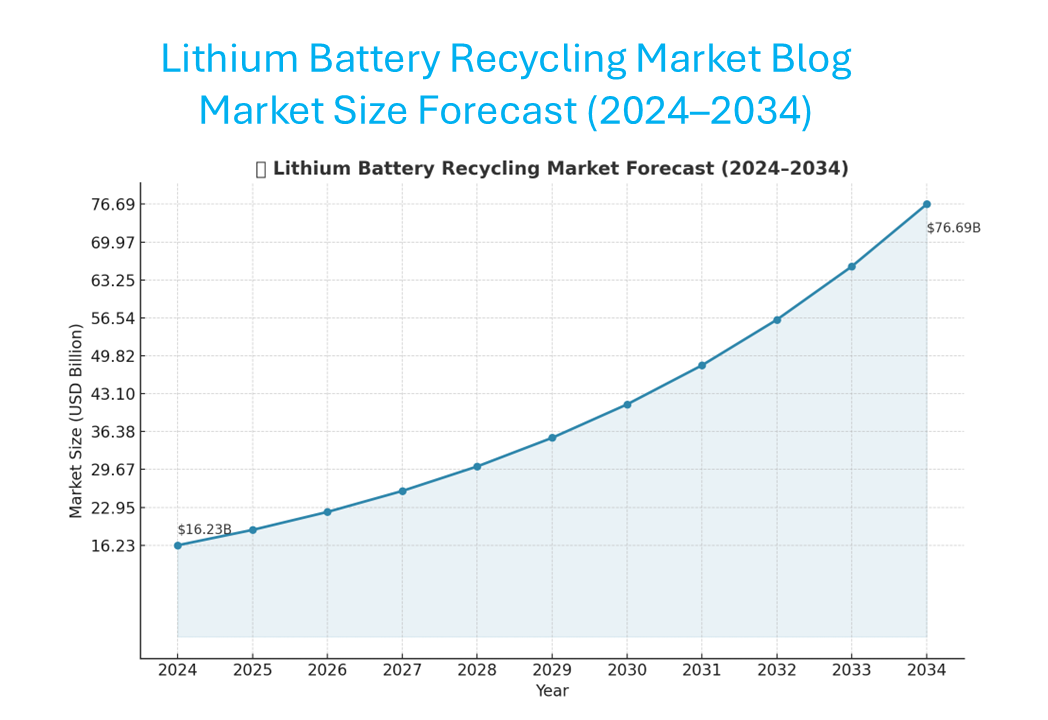

Published Date : 2025-Apr-17
The lithium battery recycling sector is booming due to rising demand for electric vehicles (EVs), energy storage systems, and stricter sustainability regulations. These companies are pioneering tech-driven recycling solutions like hydrometallurgy and direct recycling.
The market is expected to reach a value of USD 76.69 billion by 2034, at a CAGR of 16.8% over the forecast period (2025–2034).
Below is a curated list of the top players.

Global Lithium Battery Recycling Market Size, Share & Trends Analysis Report By Battery Chemistry (Lithium-manganese Oxide (LMO), Lithium-Titanate Oxide (LTO), Lithium-Nickel Manganese Cobalt (Li-NMC), Lithium-iron Phosphate (LFP), Lithium-nickel Cobalt Aluminium Oxide (NCA)), By Sources (Electric Vehicles, Power Tools, Electronics, Others), By Recycling Process (Hydrometallurgical, Pyrometallurgical, Physical/mechanical), By End-User (Mining, Consumer Electronics, Automotive, Industrial, Power, Marine) and Geography (North America, Europe, Asia-Pacific, Middle East and Africa, and South America), Global Economy Insights, Regional Outlook, Growth Potential, Price Trends, Competitive Market Share & Forecast (2025–2034).
The global lithium battery recycling market is growing at a rapid rate, driven by the extensive use of electric vehicles (EVs), renewable energy storage systems, and consumer products. As the demand for lithium-ion batteries surged, the number of used and end-of-life batteries is also increasing, and hence the requirement for recycling as a critical component in the battery lifecycle management. Lithium batteries consume valuable materials such as lithium, cobalt, nickel, and manganese, which are limited materials. Recycling allows salvage of the material for re-use, thereby minimizing raw material treatment reliance and supporting sustainability goals.
Environmental concerns due to improperly disposed lithium batteries are another overarching factor. Lithium batteries pose a serious environmental risk if disposed of inappropriately since they can leak toxic chemicals or catch fire. Governments, regulators, and industry stakeholders are all giving greater weight to the need to develop closed-loop supply chains where used battery materials are recycled back into manufacturing. This not only decreases the environmental impact of battery production but also decreases economic and supply risks of mining and processing of such raw primary materials.
Technological innovations in recycling technology are also revolutionizing the industry. Innovation in new recycling methods like hydrometallurgical, pyrometallurgical, and direct recycling is emerging and being optimized for offering higher recovery yields with lower processing expenses. These technologies are enhancing the efficiency of separation and purification of the components of batteries and thereby making recycling an economically more desirable option. Innovations in battery design are also being promoted to enable disassembly and recovery of materials at the end of a battery's life cycle to be simpler.
Policy incentives and regulation policies are propelling market dynamics development. Governments across the world are creating rules and extended producer responsibility (EPR) schemes to mandate recycling of lithium batteries by collecting them. Policy efforts are encouraging battery manufacturing and OEMs to establish recycling facilities and enter strategic partnerships with recyclers. To the same end, enhanced consumer awareness about environmental sustainability and safe disposal is likewise helping to place a growing quantity of batteries within recycling centres
Though overall outlook is favourable, there are also some limitations for the industry. Complexity and diversity of battery chemistries, initial high capital costs to establish recycling plants, and absence of battery design and collecting practices standardization can limit operational efficiency. Nonetheless, research continues, and all the stakeholders work together towards eliminating these limitations and developing a scalable, circular economy for lithium batteries.
Headquarters: Toronto, Canada
Founded: 2016
Employees: Approx. 400
Revenue (2024): $45+ million
Overview: A leader in resource recovery using proprietary Spoke & Hub technologies.
Key Region: North America
Headquarters: Brussels, Belgium
Founded: 1805
Employees: Approx. 11,000
Revenue (2024): Approx. $4.5 billion
Overview: A pioneer in battery recycling, especially in closed-loop systems.
Key Region: Europe
Headquarters: Nevada, USA
Founded: 2017
Employees: Approx. 400
Revenue (2024): Approx. $100 million (est.)
Overview: Founded by Tesla co-founder JB Straubel, focusing on circular battery supply chains.
Key Region: USA
Headquarters: Jiangxi, China
Founded: 2000
Employees: Approx. 5,000
Revenue (2024): Approx. $6.2 billion
Overview: A vertically integrated lithium giant with advanced recycling capabilities.
Key Region: Asia-Pacific
Headquarters: Lancaster, Ohio, USA
Founded: 1985
Employees: Approx. 250
Revenue (2024): Approx. $30 million
Overview: Among the oldest lithium battery recyclers in North America.
Key Region: USA & Canada
Headquarters: Espoo, Finland
Founded: 1998 (Battery division established 2021)
Employees: Approx. 200 in the battery division
Revenue (2024): Approx. $20 million (battery segment est.)
Overview: Offers low-carbon hydrometallurgical recycling in Europe.
Key Region: Nordic countries & EU
Headquarters: Singapore
Founded: 2005
Employees: Approx. 1,700
Revenue (2024): Approx. $300 million
Overview: Operates across 26 countries with e-waste & lithium battery recycling.
Key Region: Southeast Asia & Europe
Headquarters: Wendeburg, Germany
Founded: 2017
Employees: Approx. 50
Revenue (2024): Approx. $10 million (est.)
Overview: Known for low-CO2 mechanical and hydrometallurgical processes.
Key Region: Germany & EU
Headquarters: Gunsan, South Korea
Founded: 2000
Employees: Approx. 800
Revenue (2024): Approx. $200 million
Overview: Strong R&D focus and international partnerships.
Key Region: South Korea & Southeast Asia
Headquarters: Reno, Nevada, USA
Founded: 2011
Employees: Approx. 100
Revenue (2024): Approx. $15 million (est.)
Overview: Builds an integrated circular battery supply chain in the U.S.
Key Region: North America
Region | Key Drivers | Dominant Companies |
North America | EV growth, U.S. battery laws | Li-Cycle, Redwood, ABTC |
Europe | EU Battery Directive, Green Deal | Umicore, Fortum, Duesenfeld |
Asia-Pacific | EV boom, industrial battery waste | Ganfeng, SungEel, TES-AMM |
Would you like me to add more details on specific companies or market trends? Let me know! CLICK HERE
Intellectual Market Insights Research is a global market intelligence and consulting organization that provides syndicated research reports, customized research reports, and consulting services. We are known for our actionable insights and authentic reports in various domains including, Semiconductor, aerospace, Automation, Agriculture, Food & Beverages, Automotive, Chemicals and Materials, and virtually all domains and an exhaustive list of sub-domains under the sun. We create value for clients through our highly reliable and accurate reports.